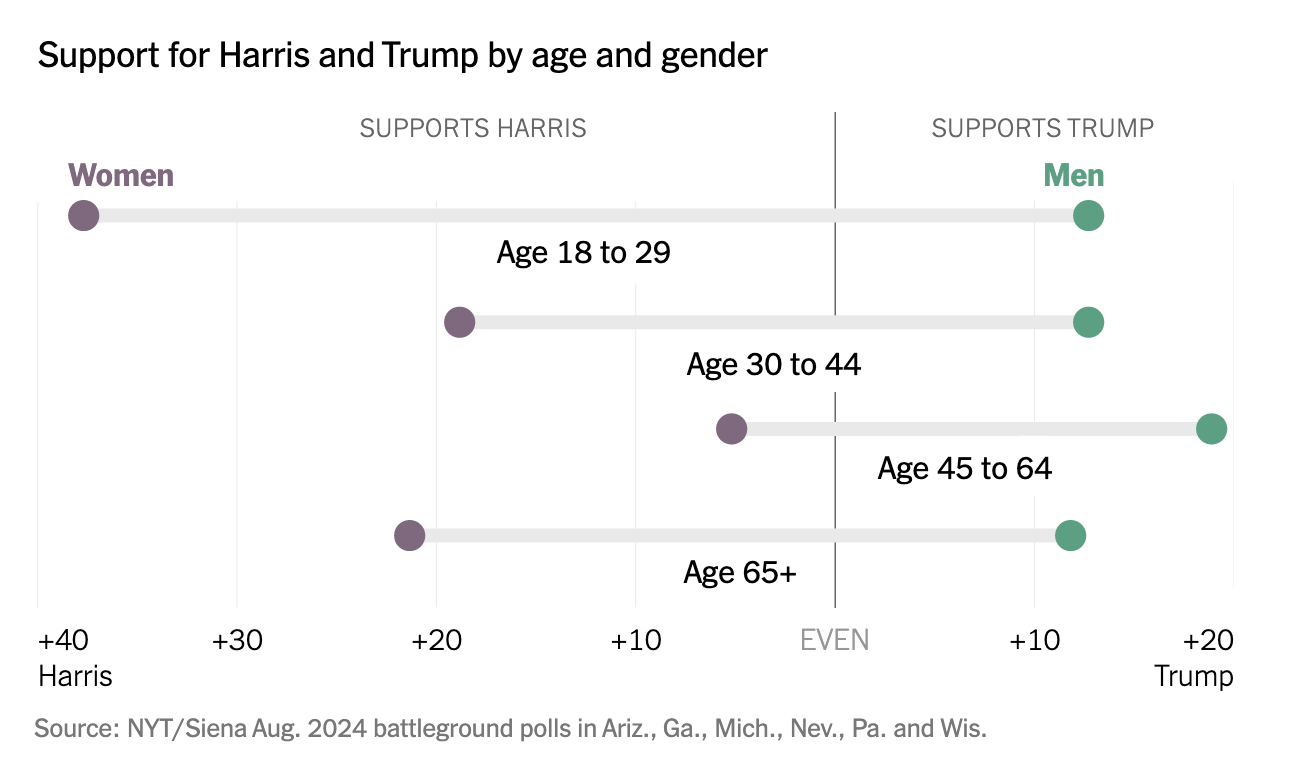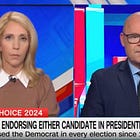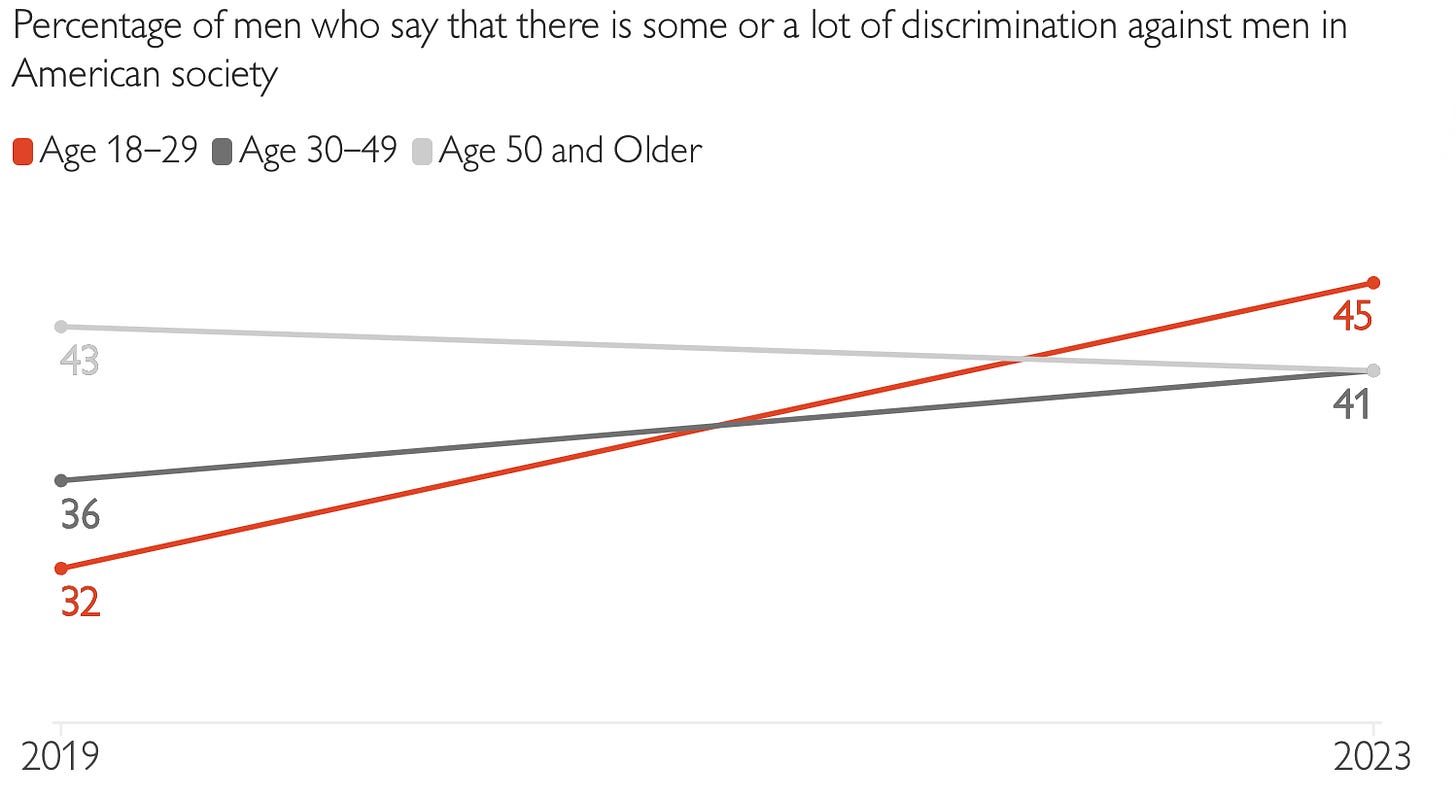How Democrats lost young white men (and how to get them back)
Alienation is a hell of a drug
Welcome to a Monday evening edition of Progress Report.
I’ve got a long feature for you tonight, so here are just a few notes ahead of that:
A judge in Georgia tossed the state’s six-week abortion ban, allowing access to the procedure up to fetal viability. The decision is very likely to be appealed.
More important litigation in Georgia: Democrats filed a third suit against the GOP Election Board’s illegal changes, this one against the requirement that counties hand count paper ballots on election night.
The Justice Department sued Alabama over its voter purges, which came after the 90-day pre-election moratorium.
The New York Mets pulled off the impossible and made the playoffs after winning one of the most captivating games in franchise history. This is important.
OK, let’s get to the big story.
Note: To make this work as accessible as possible, I’ve lowered the price for a paid subscription back down to Substack’s $5 minimum. If you can’t afford that right now, please email me and I’ll put you on the list for free. Every paid subscription makes it easier for me to comp one while becoming sustainable.
The game-of-inches nature of this year’s presidential election suggests an evenly divided American electorate while actually reflecting a series of major cultural and partisan divides.
Politically speaking, race and age have always been key factors in predicting partisanship, and at many points, so have economic class and geographic location. This year, the big new schism is the divide between male and female voters, which has never been wider. It’s been fueled — or perhaps has fueled — by a hard right turn taken by working class white men, and further exacerbated by the drift of young male voters to Republicans.
In CNN’s latest national poll, released last week, Trump held a 64%-29% lead over Harris among white non-college voters, good for a 35-point lead. That’s consistent with what we’re seeing in most statewide polls — in the New York Times’ brand new poll of Michigan, the former president leads the current vice president 61%-28% among white non-college voters.
The NYT’s Michigan poll also presents an unexpected age breakdown, with Trump leading Harris by one point among voters 18-29 and seven points among those 30-45, while the VP leads by four and five points with voters 46-64 and 65+, respectively. It’s important to not give such small subgroups in state polls too much weight, but even if the NYT misprinted these numbers, the young voter percentages would still be very alarming.
They also aren’t likely a fluke; in August, the NYT poll found that a majority of young men in swing states supported Trump by 13 points — a larger gap than when Joe Biden was the nominee.
Looking more specifically at young voters, the Harvard Institute of Politics’s new youth poll offers largely positive numbers for the vice president, but there are still several warning signs. When asked about their ideology, the number of men who said they were conservative (24%) matched the number of men who identified as liberal. More alarmingly, more men ages 18-24 said they were conservative (26%) than said they were liberal (22%). Women, meanwhile, were far more liberal (36%) than conservative (19%).
Harvard’s pollsters didn’t offer gender breakdowns on this one, but respondents who didn’t have a college degree and weren’t enrolled in higher education also were more likely to say they leaned conservative (25%) than liberal (23%). That helps to account for the fact that 42% of non-college voters said they were in favor of mass deportations of immigrants, compared to just 37% who were against it.
A view from the frontlines
This is an issue that I dove into in the newsletter a few weeks ago, and as the election draws near and some polls show industrial swing states tighter than ever, I reached out to somebody who is on the frontlines of all these trends for further insight.
Michigan state Rep. Joey Andrews won his the 38th district by just 1505 votes in 2022, winning one of the final seats that Democrats needed for a trifecta in Lansing. Elected at 34 years old after years spent working for the AFL-CIO, his district is comprised of Southwest lakeshore communities where many residents still work in manufacturing. Andrews’s hometown of St. Joseph voted for Biden in 2020 after choosing Trump in 2016.
To win re-election, Andrews will have to reassemble the fragile coalition that has carried Democrats over the finish line in recent years, which will require two things: convincing white working class voters — many of them in unions — to return to the party and finding a way to connect with the young male voters who are drifting away.
His union roots and relative youth put him in position to pull off the difficult challenge, as well as someone with insight into the factors that have driven the alienation of these voters, where things have gone wrong over the past two years, and how to start reversing the trend.
The industrial disconnect
There’s a dark irony to the fact that Democrats find themselves at their lowest ebb with white working class men, as the party just led the first government in half a century to map out an industrial policy and proactively invest in the kind of construction and manufacturing jobs that pay high wages to blue collar workers. For Andrews, who has focused heavily on securing these projects and is currently fighting to build a data center in his district, the disconnect is daunting.
“Biden has done all these good things and nobody knows it: We're building factories faster than we have in 80 years, and then you talk to people, and they're like, ‘inflation,’” he says. “It's frustrating, because the signal that it sends politically is that it doesn't matter what you do. So who's gonna stick their neck out there and do this sort of stuff that's politically hard if we're basically saying you're never gonna get rewarded for it?”
To some degree, the failure to make the connection between the current president and the new employers in town is understandable: As the party that passed NAFTA and normalized trade relations with China, Democrats have been beaten up — quite justifiably — for years over the mass exodus of manufacturing jobs. The Democratic Party went from being led by Midwestern populists to coastal liberal elites, which is not something I say as a slur, but simply a matter of fact given their educational and career pedigree. That it became a big deal that Minnesota Gov. Tim Walz didn’t attend a elite university or attend law school says it all.
(Yes, Republicans are generally just as likely to come from the world of the elites, but they are willing to invoke cultural grievances that liberals rightly will not.)
This election has also been plagued by inflation, which can’t be explained away to most people by explaining corporate price gouging and supply chain snags. What most people know is that the price of everyday necessities and housing is far higher now than in 2019, and it’s happened under a Democratic president.
Still, the Biden administration’s record on workers rights, aggressively pro-union NLRB, picket line visits, prevailing wage guarantees, upswing in manufacturing, and more recent downturn in inflation could be potent talking points with the right leadership. So could the GOP’s fealty to corporations and billionaires, history of punishing working people, and dreadful plans to dismantle labor rights, not to mention Trump’s comment last week about refusing to pay workers for overtime.
But it was President Biden who led on these issues, and he was turned into a punching bag by the right and largely unable to defend himself, let alone pitch an agenda.
With a new standard-bearer, the party largely abandoned the rebuilding America narrative, even if Harris has come out with some strong statements on issues like the attempted takeover of US Steel and been endorsed by every major labor union save for the national Teamsters. Populist industrial politics are simply not in her wheelhouse, which is fine, but it’s somewhat strange that the campaign has not assigned it to Walz, who was chosen for his Midwestern everyman appeal.
That’s put the onus on local elected officials and union leaders to convey the message to their constituents and members, which hasn’t been all that fruitful.
“I've been talking a lot of my union friends, and they're trying to convey to their members that the reason that we have work for the next 15 years is because of the IRA and the CHIPS Act, and these big projects are only happening because Democrats invested in making these big projects happen,” Andrews relays. “And then people are like, ‘Yeah, but the Democrats are gonna take my guns away, and what about all these immigrants?’”
This is the power of right-wing media, as well as lived experience. There are decades worth of resentment to overcome, and it doesn’t happen in one summer under a candidate who isn’t a natural populist.
Harris is far more powerful on issues like reproductive and civil rights. Democrats have repeatedly leaned into abortion over the past few years, and it’s been very effective, especially during the midterm elections. It has also sent women to the Democratic Party in record numbers, which is just as important as winning men. But with Trump back on the ticket and the presidential election a referendum on the economy, it may not be enough.
Andrews understands the fundamental importance of abortion rights; he simply wants to see the party not abandon its lunchpail economic message, which has largely been swapped out for a small business economy and tax credit agenda, because blue collar men are not responding to abortion politics in the same way. President Obama won working class voters in 2012, while Harris trails by 18 points.
“I worry about that as we've kind of become a little too focused on a handful of social issues that we're not thinking about what a future coalition might look like,” he says.
It’s a hard topic to broach, because it could read as if he’s implying that standing up for people’s rights shouldn’t be a priority. That’s far from the case; instead, it’s a plea for economic populism to exist alongside those issues. Otherwise, conservatives are free to launch cynical and shameless attacks that warp public discourse, and when Democrats are not proactive, the national debate winds up being about who can play youth sports and whether a beer company is too woke, not how much new housing to build and how to permanently eliminate medical debt.
The young and disaffected
This, in turn, is where young men come into play.
“Donald Trump forced us into this place where we had to start talking about needing to protect the LGBTQ community, needing to protect trans people, needing to protect Black and brown people, and that was all important,” Andrews says. “But as we were doing that, all these white men heard was ‘everybody but me.’ Women's rights matter. Black lives matter. This stuff matters, but [to young white men] nobody's talking about ‘me.’ I think that it became pretty alienating. And the Republican Party was very willing to talk directly to them.”
My natural instinct is to tell these whiny guys to get over themselves, that nobody has to protect white men because they still largely run the show. But as old as I feel saying it, I grew up in a different time, and recent poll numbers prove it: More than 50% of millennial men consider themselves feminists, while just 43% of Gen Z men claim that mantle.
There are a lot of factors at play here, from the atomization of society, especially during Covid, to the fact that young men are largely falling behind, with far fewer men than women enrolled in college and most hourly labor still concentrated in traditionally female fields like nursing and other care work. Most young men don’t think they’re experiencing so-called male privilege — not being aware of it is paradoxically evidence of privilege — and they wind up bristling at what often feel like accusations made by important social movements like #MeToo and Black Lives Matter.
“I think a lot of these guys went through their teenage years feeling like anything that they did was wrong,” Andrews says, echoing with what I wrote a few weeks ago. ”Not to say that there wasn't a culture shift needed — toxic masculinity is real, I was a teenage boy in the early 2000s and I sucked and all the dudes around me sucked, because that was the culture of the time. But it's hard to grow up and feel like you're just bad, you know?”
For context: Both Andrews and I were in middle and high school during the heyday of Jackass, the American Pie movies, and Girls Gone Wild being advertised nonstop on cable TV. Idiotic adults crawled around in Hummers and the War on Terror activated some of our worst jingoistic impulses. All of those things (maybe minus Jackass) became faux pas, or at least largely mockable, by the time Trump got elected and women rallied on Inauguration Day in DC.
That shift away from swaggering Bush-aligned patriots and pervy man-children was good for society, but it spawned a right wing backlash against “cancel culture,” which opened the floodgates to a reactionary media that targeted grandkids instead of grandparents. "Guys like Joe Rogan and Andrew Tate draw huge audiences of disaffected young men because, in some ways, they're giving them permission to “embrace being a dude,” as Andrews puts it.
This is not an endorsement of going back to blissful ignorance for young white men. Instead, it’s a frank diagnosis of what’s they’re reacting to, and how it’s being exploited.
Trump has long been a fixture, personally or as an omnipresent topic, in far-right, male-focused media, as an avatar of their collective id. Long before his campaign decided to specifically target the undecided young men who make up around 11% of swing state voters, Trump was a regular at UFC matches and WWE events, and now he’s appearing on podcasts, Twitch streams, and other enormously popular platforms that are likely foreign to anybody over the age of 40.
Democrats have also courted and utilized social media influencers, and had an array of well-known creators at the DNC, but their regulars seem like a grab bag of student council presidents who are constantly on poll-tested message. There are chatbots with more personality.
The backlash cycle went thusly: As #MeToo and trans rights and Black Lives Matter marches swept the nation, corporations and school districts rushed to implement DEI programs that would help combat systemic inequity. That inspired charges of “reverse racism,” which is idiotic, but lo and behold, the same survey that found a majority of Gen Z males rejecting feminism also found them feeling as if men were the real victims of discrimination.
I don’t know whether there’s an all-encompassing algorithm that can accurately assess levels of discrimination, but I’m confident that men — especially white men — would not be at the top of any list of targeted demographics that such a formula might produce. At the same time, “you don’t have it as bad as others” has never really been a broadly convincing argument, and the men of Gen Z were not exempt from the hardships of their era, starting with the foreclosure crisis and then on to the opioid epidemic and Covid.
So here’s the task: Progressives must make sure that women, the LGBTQ+ community, and people of color are not in any way diminished or asked to minimize their own needs. But they also need to avoid castigating white men so broadly that young men, who are not responsible for the sins of their forebears, feel targeted.
“I've actually had some really hard discussions with other Democrats, particularly Democratic women, about this,” Andrews says. “We can't keep vilifying young white men. We have to address this mental health crisis that they have, and we have to address this culture. And I know it feels like I'm saying we need to focus on white guys, which seems antithetical to what we're supposed to be doing. But they need help, and they need role models, and they do need [our] focus.”
None of this should imply that being an angry, bitter loner or congenital frat guy are the only reasons that young men support Trump; plenty also remember his term, at least pre-Covid, as a better time for them financially, or are just breaking into a difficult job market in the Biden era. Fair enough; we’ll keep the focus on disaffection.
Rebuilding the coalition
Republicans are exploiting this growing alienation every single day, declaring war on reality and trying to commandeer society’s evolving conscience. Far-right sickos like Charlie Kirk and Chris Rufo whip up frenzies around trans kids and history lessons on slavery for mendacious cowards like Govs. Ron DeSantis and Greg Abbott to convert into cruel new laws that are affirmed by conservative judges on hijacked courts.
So here’s where we ask the obvious question: Couldn’t Democrats just say screw it and rely even more on women and minority voters?
Even if the nature of the Senate and Electoral College didn’t preclude that possibility, its viability would rest on the assumption that women and minority voters would stick with Democrats even after Trump is gone. And while one might expect that the GOP’s bigotry to solidify the positions of the most stalwart members of the Democratic coalition, after several generations of neoliberal leaders who rested on the idea that demographic shifts would soon guarantee them a semi-permanent majority, it’s not just white men starting to drift away.
New polls show VP Harris, a Black woman, underperforming Biden’s 2020 performance with Black men and Latino voters; a few weeks ago, a Reuters poll found that 25% of young Black men backed Trump, and in such a close race, even small gains by Trump with people of color could cost Democrats the election. In Michigan, for example, a slump with Black voters in the Detroit area would be fatal.
“Republicans know Black and brown voters are increasingly skeptical of the Democrats because we don't really deliver wins for their communities despite promising them,” Andrews says. “If minority voters stop polarizing along racial lines and start polarizing around education and income, then we're going to lose a big chunk of voters to the Republicans at that point. We’ll start losing urban districts because we're suddenly 50/50 with Black voters, and then we're in a whole hell of a lot of trouble.”
Young Black and Latino men are driving the small rightwards drift, and there are a number of factors at play, including the decline in church attendance among young Black men to the religious piety of assimilated, more conservative Latino communities. Andrews suggests emphasizing broader economic programs that focus more on economic class than anything else. Some of the policies passed by Michigan Democrats this term stand out as prime examples, like free meals at schools and restoring the earned income tax credit, as well as continuing to build and tout the projects they fund.
“I always tell people that the class struggle is the fundamental struggle, and at the end of the day, we should be trying to highlight for working class white men why they have more in common with a working class Black man than they do with any CEO,” he says.
Actually breaking through with that message is far more challenging, which is where building up a progressive media infrastructure, driven by culture as much as politics. That’s what often produces the trust and solidarity required to get people on board and build a coalition.
Wait, Before You Leave!
Progress Report has raised over $7 million dollars for progressive candidates and causes, breaks national stories about corrupt politicians, and delivers incisive analysis, and goes deep into the grassroots.
None of the money we’ve raised for candidates and causes goes to producing this newsletter or all of the related projects we put out. In fact, it costs me money to do this. So, I need your help.
For just $5 a month, you can buy a premium subscription that includes:
Premium member-only newsletters with original reporting
Financing new projects and paying new reporters
Access to upcoming chats and live notes
You can also make a one-time donation to Progress Report’s GoFundMe campaign — doing so will earn you a shout-out in the next weekend edition of the newsletter!









This is why the so called GOP is so despicable. They are using racial warfare and blatant racism to lure white male voters. The fact that it is working is what I have a hard time with. White males are the most privileged in our nation and frequently vote against their self interest. They go for racists who do not deliver on any promises. They believe it when they are told they are under attack. The corporate media is complicit in this as they rarely tell the truth on anything. This election and our country’s very survival is at stake and all they can say is “What about me?” The lies that vance and trump and the entire republican party have told continue to go unchecked. Media outlets have normalized the republican kind of talk. It is sad that we continue to repeat the worst of our history over and over again. The beneficiary of bad policies does not want those policies to change. Sad indeed. Musky is a bigoted person who gets massive government subsidies. He should be deported for his actions alone.
Here is an outside View from switzerland. I See it Like that: why is everything related to Gender And Race. Why Not concentrate on working class people And the middle Class. If you manage to get in the Head of this Demographic you will win. The people care about Inflation And have Fears about getting enough Food on the table in the Future. These topics Are crucial for your Country. Dont concentrate so much on dividing the people by Race And gender. Find a way to adress the people wich is Not filtered by Race And gender.